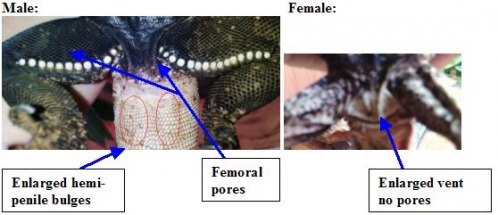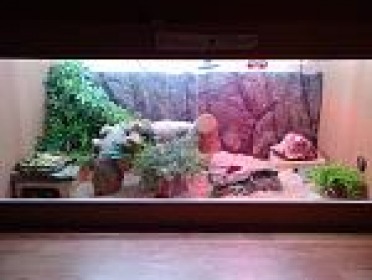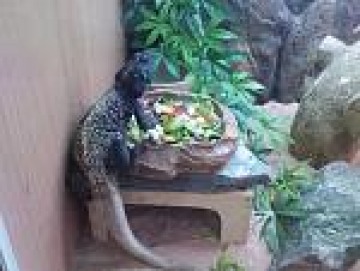PLEASE NOTE
The information on the BambooZoo site is as much as 10 years old and in the hobby much has been learned. Though, I believe there is merit in keeping the site open. There are many controversial issues presented in these pages. Please view BambooZoo as a starting point in your research.
These beings are as complicated as we are and deserve more than a basic 5 paragraph care sheet to maintain their health and well being.
My passions have evolved. This is is the site I am growing today. We Heal the World
CHUCKWALLA CARE
WRITTEN BY: Emily Schofield 2009
www.emilysreptilejungle.webs.com
Sauromulus Obesus/ Ater (Common Chuckwalla)
Obesus meaning obese in Latin, they are named so because of the folds of loose skin which are used when the lizard fills its lungs with air to wedge itself in-between rocks to evade predators.
EXPERIENCE LEVEL
intermediate
LIFE EXPECTANCY
Can live up to 25 or older in captivity no exact age is known.
APPERANCE
They range in size from 11 to 18 inches in the larger males and subspecies the average size for a male common Chuckwalla tends to be around 15 inches. Also depending on the subspecies Chuckwallas range from black with white or cream flecks with a striped grey and cream tail, to a grey with orange flecks in the calicos or with orange tail or back in males of certain subspecies. The common Chuckwalla male tends to be overly black, with cream flecks, which will increase in number and intensity of colour depending on the height of the Chuckwallas core temperature, in order to regulate heat, with a cream and grey striped tail that continues to fade with age.
Females tend to have a more streamlined body shape and head and tend to a brown speckled colouration or retain there juvenile stripe pattern which again tends to fade as the chuckwalla reaches the age of about 5 or 6. photo male female goes here
www.emilysreptilejungle.webs.com
Sauromulus Obesus/ Ater (Common Chuckwalla)
Obesus meaning obese in Latin, they are named so because of the folds of loose skin which are used when the lizard fills its lungs with air to wedge itself in-between rocks to evade predators.
EXPERIENCE LEVEL
intermediate
LIFE EXPECTANCY
Can live up to 25 or older in captivity no exact age is known.
APPERANCE
They range in size from 11 to 18 inches in the larger males and subspecies the average size for a male common Chuckwalla tends to be around 15 inches. Also depending on the subspecies Chuckwallas range from black with white or cream flecks with a striped grey and cream tail, to a grey with orange flecks in the calicos or with orange tail or back in males of certain subspecies. The common Chuckwalla male tends to be overly black, with cream flecks, which will increase in number and intensity of colour depending on the height of the Chuckwallas core temperature, in order to regulate heat, with a cream and grey striped tail that continues to fade with age.
Females tend to have a more streamlined body shape and head and tend to a brown speckled colouration or retain there juvenile stripe pattern which again tends to fade as the chuckwalla reaches the age of about 5 or 6. photo male female goes here
SEXING
Males have femoral pores which excrete a white waxy substance similar to rice in appearance, they also have enlarged hemi-penile bulges at the base of the tail. Females lack the pores and tend to have one bulge only if any at all. PIC HERE
HABITAT AND BEHAVIOUR
Chuckwallas originate in the Mojave and Sonoran Deserts range from California, Southern Nevada and Utah, western Arizona and south to Sonora, Mexico and the mainland and islands of Baja. They inhabit the rocky outcrops and open flats there and love to climb on and into the rocks. They will bask during the morning and are most active at the hottest part of the day and graze on their natural food sources of fruit, leaves, buds and flowers, especially yellow flowers. (such as the dandelions and nasturtiums in the UK.)
BASIC CARE
Chuckwallas do not require water as adults as they obtain almost all of it from the food that they eat, however water can be offered in a shallow bowl for a couple of hours everyday and baths may be given once a week, maximum, to help during shedding. 15mins is the maximum time in water around blood temperature to prevent any respiratory or skin infections. In captivity the cage should be spot cleaned every day to remove feces and sift the substrate once a week to remove any old food matter or any missed waste. A full change of substrate and washing of any fake plants, rocks and hides should be done once every 1-2 months and a tile or newspaper base can be used if an animal is sick or for convenience.
FEEDING
Chuckwallas can be offered food every day and can be offered a wide range of vegetables, fruit and flowers to give a varied and nutritious diet, insects such as grasshoppers, mealworms and waxworms (as a treat only or to build up for breeding weight) may be offered 1-2 times a week or everyday for gravid females.
Vegetables: Kale, and other dry and romaine lettuces, grated butternut squash, mustard greens, sweet pea, dandelions and nasturtiums (both the leaves and flowers), carrots (once a week due to high potassium content). This should be 80% of the diet.
Fruit: strawberries, kiwi, mango, prickly pear, apples and grapes. CABBAGE (ALL THE TIME CUT UP FINELY)20% of the diet maximum.
Lentils, bee pollen and bird seed can also be offered. FOR THE SOFT LEAFY GREENS I USE WAITROSE ESSENTIALS RANGE MIXED SALAD 250g. IT'S THE CHEAPEST FRESHEST FOR LONGEST SALAD I HAVE FOUND AND ITS EASIER TO USE. LASTS ABOUT A WEEKS FEED, BIT MORE IF HE DOESNT EAT SO MUCH. NEED ABOUT A GOOD HANDFUL, STILL NEED TO CUT IT UP INTO STRIPS COZ ITS WHOLE LEAVES.
Chuckwallas can be offered food every day and can be offered a wide range of vegetables, fruit and flowers to give a varied and nutritious diet, insects such as grasshoppers, mealworms and waxworms (as a treat only or to build up for breeding weight) may be offered 1-2 times a week or everyday for gravid females.
Vegetables: Kale, and other dry and romaine lettuces, grated butternut squash, mustard greens, sweet pea, dandelions and nasturtiums (both the leaves and flowers), carrots (once a week due to high potassium content). This should be 80% of the diet.
Fruit: strawberries, kiwi, mango, prickly pear, apples and grapes. CABBAGE (ALL THE TIME CUT UP FINELY)20% of the diet maximum.
Lentils, bee pollen and bird seed can also be offered. FOR THE SOFT LEAFY GREENS I USE WAITROSE ESSENTIALS RANGE MIXED SALAD 250g. IT'S THE CHEAPEST FRESHEST FOR LONGEST SALAD I HAVE FOUND AND ITS EASIER TO USE. LASTS ABOUT A WEEKS FEED, BIT MORE IF HE DOESNT EAT SO MUCH. NEED ABOUT A GOOD HANDFUL, STILL NEED TO CUT IT UP INTO STRIPS COZ ITS WHOLE LEAVES.
LIGHTING AND UVB
The best lighting is usually a red or white 100-60W heat lamp for the basking area set at 45ºC-55ºC under the lamp and a temperature gradient down to 28ºC in the cool end of the vivarium this can decrease overall by roughly 10ºC if you should choose to brumate your chuckwallas during the winter (lamps should always have guard cages on them). The temperature at night should be around 15-20ºC so a 40-60W red heat lamp or ceramic lamp can be used if the temperature of the area they are kept goes below this level.
All heat lamps should be attached to a thermostat (dimming is best) in order to prevent overheating and a pulse proportional thermostat is required with any ceramic heat lamps.
For UV chuckwallas require the wide range UV spectrum lights at about 10-12% UVB and a double set of strip lights running the full length of the vivarium is the best to use, they require 12-14 hours a day which can go down to 8-10 hours during brumation.
U WILL NEED A THERMOMETER IN THE HOT END TO MONITOR THE BASKING AREAS HEAT BECAUSE MOST THERMOSTATS DONT GO HIGH ENOUGH TO STAY AT THE RIGHT TEMPERATURE I JUST LEAVE MINE ON WITHOUT THE THERMOSTAT AND ITS FINE LIKE THAT.
The best lighting is usually a red or white 100-60W heat lamp for the basking area set at 45ºC-55ºC under the lamp and a temperature gradient down to 28ºC in the cool end of the vivarium this can decrease overall by roughly 10ºC if you should choose to brumate your chuckwallas during the winter (lamps should always have guard cages on them). The temperature at night should be around 15-20ºC so a 40-60W red heat lamp or ceramic lamp can be used if the temperature of the area they are kept goes below this level.
All heat lamps should be attached to a thermostat (dimming is best) in order to prevent overheating and a pulse proportional thermostat is required with any ceramic heat lamps.
For UV chuckwallas require the wide range UV spectrum lights at about 10-12% UVB and a double set of strip lights running the full length of the vivarium is the best to use, they require 12-14 hours a day which can go down to 8-10 hours during brumation.
U WILL NEED A THERMOMETER IN THE HOT END TO MONITOR THE BASKING AREAS HEAT BECAUSE MOST THERMOSTATS DONT GO HIGH ENOUGH TO STAY AT THE RIGHT TEMPERATURE I JUST LEAVE MINE ON WITHOUT THE THERMOSTAT AND ITS FINE LIKE THAT.
CAGING REQUIRED
A 4ft X 2ft X 2ft wooden vivarium is sufficient for 1-2 medium sized chuckwallas, another Ft will be required in depth and length if more chuckwallas are added, males should not be kept together. When mature a male kept with 2 females is best with this species. A sand substrate can be used with a depth of 2-5 inches to allow natural digging behaviour a deeper substrate is required for gravid females with nest boxes. One hide is required per chuckwalla and can be placed in various temperature gradients around the vivarium, plenty of rocks and climbing platforms or wood such as bogwood and bamboo root are excellent stimulation and a rock or flat piece of wood should always be available under the heat source. DO NOT USE HEATED ROCKS chuckwallas tend to burn themselves on these as the stay for too long. A polystyrene background can also be used to keep your chuckwallas well exercised, as they love to climb. You can also allow them outside in a rabbit run or other enclosure for 15mins on very hot days to allow them to graze and exercise, just ensure no poisonous plants are within the chuckwallas reach so they wont eat them.
SUPPLEMENTS AND VITAMINS
calcium supplement should be put on any food items 2-3 times a week and more often with sick or gravid animals. Keep up a varied diet to give your chuckwalla a good balance of minerals and vitamins.
A 4ft X 2ft X 2ft wooden vivarium is sufficient for 1-2 medium sized chuckwallas, another Ft will be required in depth and length if more chuckwallas are added, males should not be kept together. When mature a male kept with 2 females is best with this species. A sand substrate can be used with a depth of 2-5 inches to allow natural digging behaviour a deeper substrate is required for gravid females with nest boxes. One hide is required per chuckwalla and can be placed in various temperature gradients around the vivarium, plenty of rocks and climbing platforms or wood such as bogwood and bamboo root are excellent stimulation and a rock or flat piece of wood should always be available under the heat source. DO NOT USE HEATED ROCKS chuckwallas tend to burn themselves on these as the stay for too long. A polystyrene background can also be used to keep your chuckwallas well exercised, as they love to climb. You can also allow them outside in a rabbit run or other enclosure for 15mins on very hot days to allow them to graze and exercise, just ensure no poisonous plants are within the chuckwallas reach so they wont eat them.
SUPPLEMENTS AND VITAMINS
calcium supplement should be put on any food items 2-3 times a week and more often with sick or gravid animals. Keep up a varied diet to give your chuckwalla a good balance of minerals and vitamins.
BREEDING AND INCUBATION
Chuckwallas will exhibit mating behaviour called head bobbing during the breeding season, this looks like the male is doing press ups and shaking his head vertically up and down. This usually happens around January and the females will lay their eggs around June. The eggs require a dry incubation with lightly damped vermiculite substrate and misting when the eggs appear to sink slightly., Temperatures of 30-32ºC (incubation for females) for around 75-80 days, the first 2-3months are crucial and many die during this time, babies eat the same as the parents but also require the feces of the parents to help increase their natural gut bacteria and this should increase there chances of survival. They do need water unlike the adults and need to be watched for signs of aggression between siblings and must be separated to prevent loss of limbs or other damage.
These animals are very difficult to hatch successfully in captivity with about 3 eggs hatching in a clutch of 10 if they are not watched carefully or humidity is too high.
YOU PROBABLY WONT NEED THIS LAST BIT ITS FOR MY BENIFIT COZ I WILL BREED HOPEFULLY NEXT YEAR CHUCKS AND IGGIES.
Chuckwallas will exhibit mating behaviour called head bobbing during the breeding season, this looks like the male is doing press ups and shaking his head vertically up and down. This usually happens around January and the females will lay their eggs around June. The eggs require a dry incubation with lightly damped vermiculite substrate and misting when the eggs appear to sink slightly., Temperatures of 30-32ºC (incubation for females) for around 75-80 days, the first 2-3months are crucial and many die during this time, babies eat the same as the parents but also require the feces of the parents to help increase their natural gut bacteria and this should increase there chances of survival. They do need water unlike the adults and need to be watched for signs of aggression between siblings and must be separated to prevent loss of limbs or other damage.
These animals are very difficult to hatch successfully in captivity with about 3 eggs hatching in a clutch of 10 if they are not watched carefully or humidity is too high.
YOU PROBABLY WONT NEED THIS LAST BIT ITS FOR MY BENIFIT COZ I WILL BREED HOPEFULLY NEXT YEAR CHUCKS AND IGGIES.
Emily is working on her own site:
www.emilysreptilejungle.webs.com








